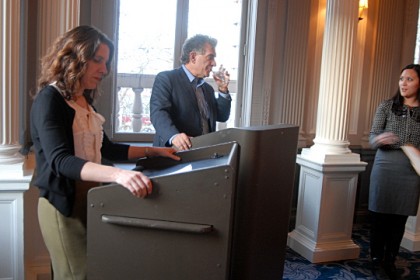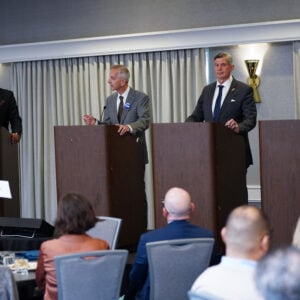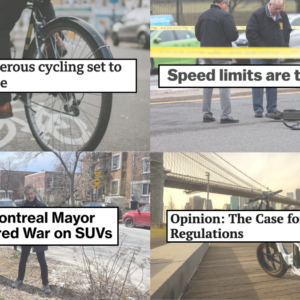
Francesconi, right, is a former city commissioner.
(Photo by M.Andersen/BikePortland)
Transportation is rarely the biggest issue for Multnomah County chairs, but that didn’t stop candidates Deborah Kafoury and Jim Francesconi from gamely finding some modest differences at a debate on the subject Tuesday.
Though neither politician has been known as particularly passionate on transportation issues, both contenders for the county’s top elected position endorsed the concept of a “multimodal” county and shared a few ideas for making it better.
Speaking at a topical event hosted by the Portland chapter of the Women’s Transportation Seminar, they devoted much of the 45-minute exchange to discussing the county’s most famous transportation responsibilities: the Sellwood, Hawthorne, Morrison, Burnside, Broadway and Sauvie Island bridges.
“The bridges are popular… It’s a popular high priority, unlike maintaining roads in Fariview. How are they going to fund that? They can’t even fund police and fire in Gresham. So you’ve got to pick issues that you can move.”
— Jim Francesconi, candidate for Multnomah County Chair
Kafoury, a county commissioner for the last five years, thinks the county has been doing fine at managing them and doesn’t need to cede power to a separate “regional bridge authority.”
“We’re a national model,” she said. “Three of our bridges are over 100 years old, and our staff knows how to keep them going. Yes, they need to lift them every eight hours to make sure they’re still working, but it’s a small price to pay for living the Portland example of reduce, reuse, recycle.”
“The discussion about the regional bridge authority is really missing the point,” Kafoury said. “The point is that we need the funding for the bridges.”
Francesconi, a former city commissioner, agreed that the county is in trouble if it can’t find more money for bridge maintenance and upgrades, but seemed open to the idea of letting Metro or TriMet take the lead with a new regional bridge authority. But with the county also struggling to maintain miles of crumbling arterials in east county, he said, the bridges might actually be an asset, since Portlanders are at least passionate about them.
He hopes the county will be able to get $25 million in seismic upgrades for the Burnside Bridge into Portland’s project list for its likely ballot issue about a new transportation fee.
“The bridges are popular, and if there’s going to be a ballot issue, the bridges should be on it,” Francesconi said. “It’s a popular high priority, unlike maintaining roads in Fariview. How are they going to fund that? They can’t even fund police and fire in Gresham. So you’ve got to pick issues that you can move.”
After the debate, Francesconi added that he didn’t mean to say that the City of Portland should be the sole funder for bridge improvements, just the primary one.
Other issues they touched on:
Tolling the Willamette bridges. Both Kafoury and Francesconi oppose this, though for different reasons. Kafoury said that tolling one or several bridges would require tolling the other ones, which isn’t in the county’s power. “Do I believe that at some point, all the bridges will be tolled? Yes,” she said. “It’s just, at what point does the public realize? And I don’t think they’re there yet.”
Francesconi, in reply, immediately distanced himself from tolling as expensive to people using cars. “I’d be careful. tolling city bridges where they’ve already raised their vehicle tax to pay for it? I hope there’s better solutions than that.”
Economic inequality. This is Francesconi’s lead campaign theme. He said affordable transportation is needed to “include everybody in the life of this county” and said that, as city transportation commissioner for two years in the early 2000s, “I made the decision to go along 205 [for the Green Line MAX expansion]. It was partly because we already had right of way. But I knew we had to move transportation infrastructure east, where poverty was moving already.”
For her part, Kafoury said she’d opposed committing money to a streetcar to Lake Oswego while TriMet was cutting bus service, because of the need for “a robust transportation system that works for all.” She laid out a five-point “filter” for her transportation decisions, in descending order of importance: safety, equity, “alternative” transportation, local support and a project’s ability to leverage other sources of funding.
Bike commuting. Kafoury said she’d started doing so herself in an effort to set an example for the county’s workforce, and hopes to improve the county building’s bike parking facilities.
Freight. Francesconi said that as city transportation commissioner, he’d convened “the first freight committee in the history of PDOT” as a way to tap the expertise of people in the freight business. It’s still functioning today, he noted proudly.
Job growth. Kafoury mentioned the 5,000 construction jobs being created by rebuilding the Sellwood Bridge, a project she’d said she’d been assigned by then-chair Ted Wheeler on her first day on the job as county commissioner. Francesconi said that more human-friendly streets in the eastern half of the county would create economic value in the way that Northeast Alberta Street has. “There’s other main streets that if they had some pedestrian amenities, you could spur some main street development,” he said. “And that spurs small business growth.”
In terms of personal style, neither candidate seemed to stand out Tuesday; Kafoury (who probably had the edge in terms of charisma) read her opening statement while looking down at her notes, and Francesconi’s final words of the debate were “And uh, so anyway.”
Then again, maybe low-key politicians are a good fit for Multnomah County, an agency focused mostly on social services that Kafoury said is little-understood by its citizens.
“We don’t get that many people coming in to talk to us about their thoughts and concerns,” she said, urging the audience to make its opinions known. “There is a huge opportunity to get involved.”
Francesconi’s campaign website is here, and Kafoury’s here. The election, which will fill the seat of the resigned Jeff Cogen, will end May 20.






Thanks for reading.
BikePortland has served this community with independent community journalism since 2005. We rely on subscriptions from readers like you to survive. Your financial support is vital in keeping this valuable resource alive and well.
Please subscribe today to strengthen and expand our work.
Toll the Willamette bridges??? I did not even know that was an idea *anyone* had ever contemplated. At first thought, it seems grossly inappropriate. At second thought, I imagine we’d boost our bike commute numbers (as long as bikes cross for free).
Likewise … I’d never even thought about the possibility of tolling the bridges. Of course if you toll any of the downtown bridges you will need to toll them all (otherwise traffic will just shift around). But that would encourage alternative commuting, raise money for bridge maintenance and refurbishment, and help decongest the often-clogged bridges for those occasions when I do have a good reason to drive across the river.
I’m guessing it’s a political impossibility, as even Portlanders tend to view free roads as a birthright and people scream bloody murder at the prospect of even modest tolling. There’s also the difficulty of figuring out where to place tollbooths, when many of the bridges have multiple access paths, along with all of the other complications that go with tolling.
But I still kind of like the idea.
On the contrary, I can’t think a model of paying the toll that would lead to increased congestion. They can’t do all “easy pass”-style transponders, and setting up toll booths will snarl traffic even at non-peak hours.
sorry, “that WOULDN’T lead to increased congestion”.
But I guess you agree on this point.
You can easily have transponders at every crossing, and just mail tolls to the addresses associated with license plates for those who don’t have one. Oh, and charge a several-dollar “administrative fee” for the privilege of not owning a transponder.
I’m confused by the combination of these two statements:
…and …
It seems like Kafoury is boosting the concept, then dismissing it. Have I misread?
If I understood her correctly, her position is that the existence of a regional authority is less important than the existence of funding, but if there’s reform in who manages them, there’s no reason for someone other than the county to do so.
I’ve rephrased the wording above in an effort to make this clearer.
Thanks, Michael.
“I made the decision to go along 205 [for the Green Line MAX expansion]. It was partly because we already had right of way.”
Imagine if instead of traveling along 205, the green line went down 82nd Avenue (a la Interstate Ave). That would have been transformative for the area in a way that the 205 alignment never will be.
Interesting idea Nick. I wonder if that could have worked? There isn’t a great parallel arterial to 82nd (besides 205, which isn’t even an arterial). That would have pushed a lot of traffic onto 92nd and 72nd. I haven’t lived here long enough to comment on the Interstate traffic pre/post MAX. Anyone see major diversion there?
It worked on Interstate Ave because the volumes were so low to begin with, but 82nd is as packed as it ever was.
I tend to believe in a concept called traffic evaporation (the corollary to induced demand). If you constrain a roadway, three things can happen for sure:
– people drive at different times
– people change modes
– people take alternate routes/destinations
A fourth option is the most controversial one:
– people don’t take that trip
You also see this in cases where roads become tolled. Where did all of that traffic go? As it turns out, people make a ton of car trips that are not very important. They are so low-value that when faced with congestion or tolls, they are simply not worth taking.
http://discovery.ucl.ac.uk/33442/
MAX on 82nd Ave would have been a non-starter if it required reducing lanes to 1 each direction. There were some sections that could have been widened to accommodate MAX, and others where it would have required elevated rail. It would have been expensive, but would have hit huge ridership numbers.
A Central City congestion charge does the same thing as tolling the MultCo bridges, plus you get the Westside and Southwest commuters too. It also doesn’t necessarily require ODOT tolling the Fremont and Marquam.
https://www.youtube.com/watch?v=r0dj1adoz5o
I am very serious. I will win! Thank you for inspiring me to continue . . . The People clearly deserve better than what they’re being served up.
Good Luck. My ideas are inventive and superb! It is regrettable that so many in the local political swirl are willing to deny any viable candidate that just might be a “threat”? to the status quo of lazy. . . I intend to not only change up the chaos, I will be the absolute BEST Multnomah County Chair in the history of this state. I do not approve of mistreating the People; why would I allow this drivel to continue. Stay tuned. You will be more than surprised what I have in store for the intent of self involved children; it will be their own words that propel their undoing. I have just begun to win. The so called front runners? Why are each one of them too lazy to read? And, why are each one of them co-opting MY material? Not so fast boys & girls. Momma’s watchin’!